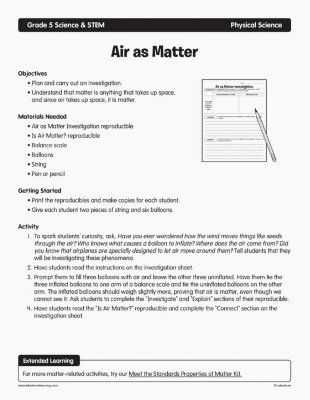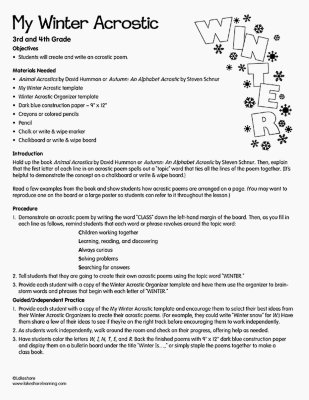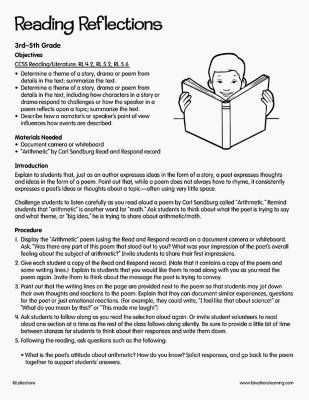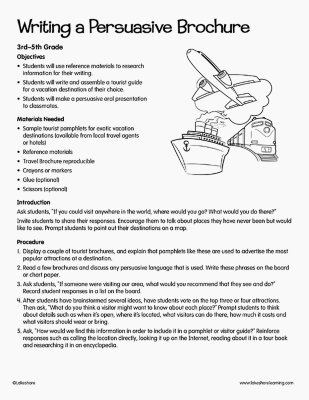Narrow by Grade
- Infant (0)
- Toddler (0)
- Preschool (0)
- Pre-K (0)
- Kindergarten (0)
- 1st (0)
- 2nd (0)
- 3rd (2)
- 4th (2)
- 5th (4)
- 6th & Up (0)
Grade
Narrow by Age
- 0-18m (0)
- 18-36m (3)
- 3 yrs. (0)
- 4 yrs. (17)
- 5 yrs. (23)
- 6 yrs. (21)
- 7 yrs. (21)
- 8 yrs. (12)
- 9 yrs. (11)
- 10 yrs. (4)
- 11 yrs. & Up (0)
Age 10 yrs.
4 results for "brights 4 ever cut outs"
Filters
Clear All
Air as Matter
5th Grade
Objectives
- Plan and carry out an investigation.
- Understand that matter is anything that takes up space, and since air takes up space, it is matter.
My Winter Acrostic
3rd Grade - 5th Grade
Objectives Reading: Literature Reading and comprehending grade-appropriate literature, including stories, dramas, and poetry Writing Writing an acrostic poem Materials Needed Animal Acrostics by David Hummon or Autumn: An Alphabet Acrostic by Steven Schnur My Winter Acrostic template Winter Acrostic Organizer template Dark-blue construction paper - 9" x 12" Crayons or colored pencils Pencil Chalk or write & wipe marker Chalkboard or write & wipe board Introduction Hold up the book Animal Acrostics by David Hummon or Autumn: An Alphabet Acrostic by Steven Schnur. Then explain that the first letter of each line in an acrostic poem spells out a “topic” word that ties all the lines of the poem together. (It’s helpful to demonstrate the concept on a chalkboard or write & wipe board.) Read a few examples from the book and show students how acrostic poems are arranged on a page. (You may want to reproduce one on the board or a large poster so students can refer to it throughout the lesson.)
View Lesson PlanReading Reflections
5th Grade
Objectives CCSS Reading/Literature: RL.4.2, RL.5.2, RL.5.6 Determine a theme of a story, drama or poem from details in the text; summarize the text. Determine a theme of a story, drama or poem from details in the text, including how characters in a story or drama respond to challenges or how the speaker in a poem reflects upon a topic; summarize the text. Describe how a narrator’s or speaker’s point of view influences how events are described. Materials Needed Document camera or whiteboard “Arithmetic” by Carl Sandburg Read and Respond record Introduction Explain to students that, just as an author expresses ideas in the form of a story, a poet expresses thoughts and ideas in the form of a poem. Point out that, while a poem does not always have to rhyme, it consistently expresses a poet’s ideas or thoughts about a topic—often using very little space. Challenge students to listen carefully as you read aloud a poem by Carl Sandburg called “Arithmetic.” Remind students that “arithmetic” is another word for “math.” Ask students to think about what the poet is trying to say and what theme, or “big idea,” he is trying to share about arithmetic/math.
View Lesson PlanWriting a Persuasive Brochure
3rd Grade - 5th Grade
Objectives Using reference materials to research for their writing Introducing the topic or text they are writing about, stating an opinion and creating an organizational structure that lists reasons Providing reasons that support the opinion Reporting on a topic or text, telling a story, or recounting an experience in an organized manner, using appropriate facts and relevant, descriptive details to support main ideas or themes; speaking clearly at an understandable pace Materials Needed Sample tourist pamphlets for exotic vacation destinations (available from local travel agents or hotels) Reference materials Travel Brochure reproducible Crayons or markers Glue (optional) Scissors (optional) Introduction Ask students, “If you could visit anywhere in the world, where would you go? What would you do there?” Invite students to share their responses. Encourage them to talk about places they have never been but would like to see. Prompt students to point out their destinations on a map.
View Lesson Plan


